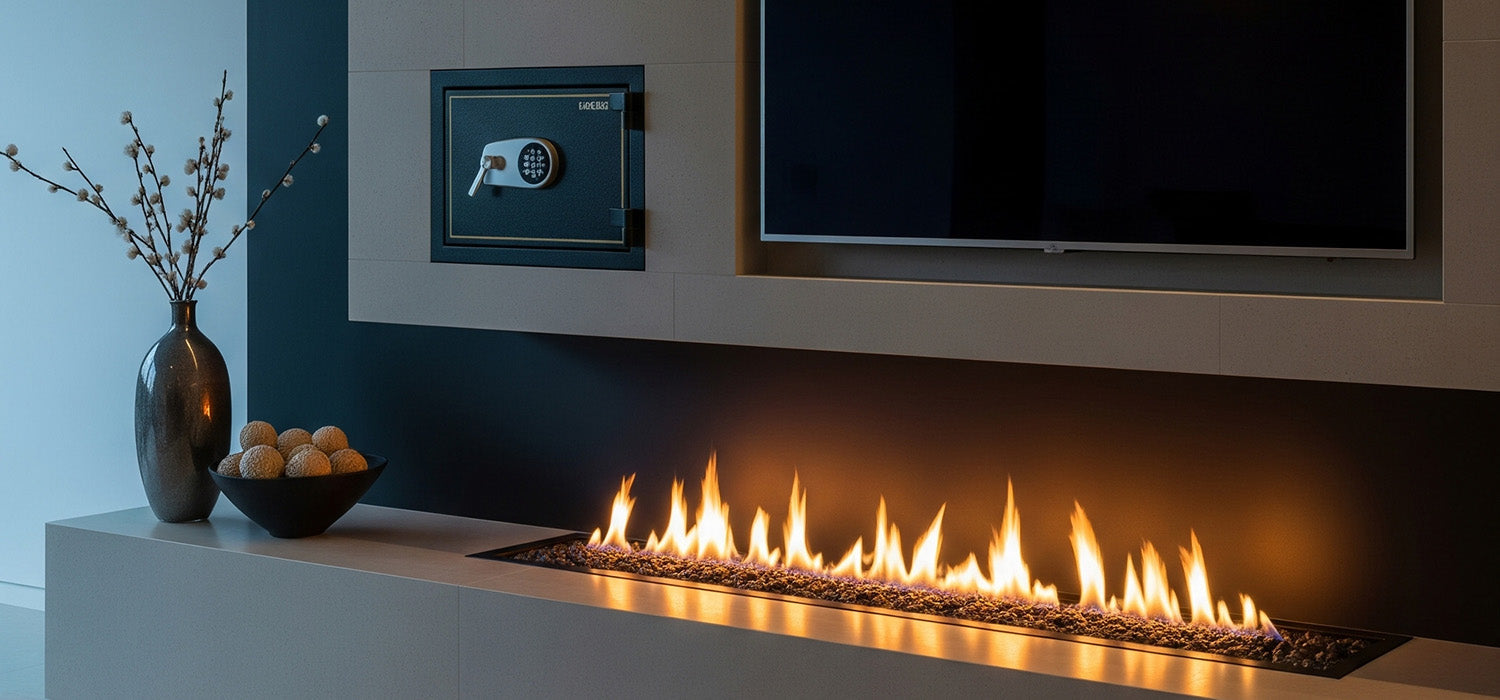
Are Media Wall Fires Safe? What Every UK Homeowner Should Know
Worried your Media Wall Fire might roast more than marshmallows?
Short answer: yes, they’re safe—when installed and maintained properly. With smart tech, strict regulations, and pro setup, they’re hot stuff in all the right ways. Keep reading to uncover the secrets behind their sleek safety and steamy style.
Understanding Media Wall Fire Types
Media wall fires are becoming the heart of modern living rooms—sleek, cosy, and loaded with features. But not all fire types are equally suited for these stylish setups. Choosing the right one can mean the difference between a glowing centrepiece and a toasty regret.
Let’s break down the different options and what makes them tick (or crackle).
Electric Fires (Most Common and Safest for Media Walls)
Electric fires are the crowd favourite—and it’s easy to see why. They don’t require a chimney, they’re easy to install, and they’re loaded with clever features that make life simpler and warmer.
Types: Inset, Wall-Mounted, Freestanding
Electric fires come in a few styles. Inset models slot straight into the wall for that clean, flush look. Wall-mounted designs hover like high-end art. And freestanding versions give you a bit more flexibility—great for renters or those not ready to commit.
Inset models tend to win the media wall popularity contest. They keep everything seamless and stylish.
Heat Output and Fan Heaters
Most electric fires kick out between 1kW and 2kW of heat. That’s plenty for most UK living rooms. Many use fan-assisted heating to warm the space efficiently, and they often include remote controls and thermostats for easy use.
No need to worry about singeing your telly—as long as you keep proper clearances.
Bioethanol Fires (Considered but with Caution)
There’s something hypnotic about a real flame, isn’t there? Bioethanol fires offer that ambience without the need for a flue or gas connection. But before you fall for the flicker, it’s worth knowing the drawbacks.
Real Flame, No Flue Required
Bioethanol fires burn liquid fuel and create a visible flame. No chimney needed. They’re a win for aesthetic lovers—and those keen to avoid major installation work.
Ventilation and Fuel Storage Concerns
However, they do consume oxygen, which means good ventilation is non-negotiable. You’ll also need somewhere safe to store the fuel. And unlike electric fires, there’s no ‘off switch’—so once it’s lit, you’re committed.
Stylish? Yes. Low maintenance? Not quite.
Gas Fires (Rare and Highly Regulated for Media Walls)
Gas fires can look amazing—real flames, serious heat. But when it comes to media walls, they’re more of a niche option.
Requires Flue and Professional Installation
You’ll need a proper flue system, which most internal media walls simply don’t have. On top of that, installation must be done by a Gas Safe registered engineer. It’s not a weekend DIY project.
Significant Safety Implications
Gas fires bring risks like leaks and combustion. That’s why they’re more common in traditional setups or bespoke builds, not your average living room renovation.
Real Wood-Burning Stoves (Not Recommended for DIY Media Walls)
We love a wood-burner in a country cottage. But in a media wall next to your 55-inch smart TV? Not the best idea.
They require a chimney, need lots of space, and aren’t suitable for modern media wall materials. Save the logs for your log cabin.
Key Safety Considerations for Electric Media Wall Fires
So, you’ve chosen an electric fire—great choice! Now it’s time to make sure it’s installed safely and runs like a dream.
Heat Output and Clearances
Manufacturer's Recommended Distances to Combustibles
This one’s easy but often ignored. Always follow the manufacturer’s guidance on how far the fire should be from flammable materials like timber frames or plasterboard. If it says 50mm clearance—don’t push your luck with 30mm.
Preventing Overheating of Surrounding Materials
Heat build-up can warp nearby finishes or damage internal structures. Use fire-rated materials wherever possible and avoid cramming the fire into a tight spot with no breathing room.
Ventilation for the Fire Unit
Ensuring Adequate Airflow for the Heater Element
Electric fires need airflow to function properly. Blocked vents reduce efficiency and increase the risk of overheating. Leave space at the top and bottom of the unit to allow for proper circulation.
Preventing Recess Overheating
If your media wall design encloses the fire too tightly, heat can get trapped. That can cause anything from discolouration to serious safety issues. Consider adding discreet vent panels if your build is tightly sealed.
Electrical Safety
Correct Wiring and Dedicated Circuit (If High Wattage)
High-output electric fires may require their own circuit. Plugging into a nearby socket is not always safe—especially if you’re already running a games console, TV, and surround sound system on the same ring.
Avoiding Overloaded Sockets
Overloading leads to overheating. Always use proper fused spurs or seek advice from an electrician if in doubt.
Overheat Protection Features
Thermostats and Automatic Shut-Offs
Most good-quality electric fires come with built-in thermostats and safety shut-off features. These cut the power if things get too warm—keeping both your fire and your furniture safe.
Cool-Touch Glass (If Applicable)
If your model includes cool-touch glass, even better—great if you’ve got curious kids or pets.
Integrating Fire and Electronics Safely
The media wall dream is all about blending tech and comfort. But heat and electronics? Not the best combo unless you’re careful.
Separating Heat Sources from Electronics
Sufficient Distance Between Fire and TV/Devices
The golden rule: don’t let your TV melt. Always maintain a safe distance—usually around 300–500mm—from the top of the fire to the base of your screen.
Using Insulating Barriers (Non-Combustible)
Some installers add a layer of cement board or a heat deflector panel between the fire and the telly. It’s a smart move, especially for smaller gaps.
Cable Management in Hot Zones
Using Heat-Resistant Cable Sleeving
If cables must run near warm zones, protect them. Heat-resistant sleeving is cheap and effective.
Avoiding Pinching or Trapping Wires
Pinched cables behind panels or fireplaces are a fire risk. Double-check all wiring before sealing your media wall.
Installation Best Practices for Safety
Don’t wing it. The best media walls follow a plan, not a Pinterest board.
Following Manufacturer's Instructions Precisely
The manual might not be thrilling bedtime reading, but it’s essential. Stick to the instructions—no improvising.
Using Appropriate Fire-Rated Materials for the Enclosure
Use fire-rated plasterboard, insulation, and framing materials. MDF alone won’t cut it—literally and figuratively.
Ensuring Structural Integrity of the Media Wall
The wall needs to hold the weight of the fire and the TV—safely. Use proper fixings and framing, especially if mounting into plasterboard.
When to Consult a Professional
Some parts of your media wall might be a fun weekend project. Others? Best left to the experts.
Gas Fire Installation
This is non-negotiable. Only a Gas Safe registered engineer should touch a gas fire.
Complex Electrical Work
If you’re adding a circuit or not 100% confident, hire a qualified electrician. Safety isn’t the place to cut corners.
Uncertainty Regarding Clearances or Materials
Not sure if something’s fire-rated or spaced properly? Bring in a pro for a quick consult—it could save you a major headache later.
Conclusion: Enjoying Your Media Wall Fire Safely
Media wall fires are a gorgeous way to warm up your space and make your home feel more luxurious. But behind the flickering flame (or glowing LED) is a bit of science and a lot of safety know-how.
Electric fires are the clear winner when it comes to ease and peace of mind. Follow the rules, use proper materials, and don’t be shy about calling in the pros.
Get it right, and your media wall won’t just look amazing—it’ll feel safe, smart, and built to last. Now that’s something worth cosying up to.
Other content we think you'll love
- Can I Build a Media Wall Myself? A DIY Guide for UK Homes
- How to Build a Stylish Media Wall with TV & Fireplace
- Can You Build a Media Wall Over a Radiator? A Stylish Guide
- Can You Build a Media Wall on Carpet? Tips for a Stable Setup
- Can You Build a Media Wall Around a Fireplace? A Cosy & Stylish Upgrade
- How to Build a Media Wall on a Chimney Breast (UK Guide)
- Can You Build a Media Wall in a Council House? A Practical Guide
- The Ultimate Guide to Buying a Pre-Made Media Wall in the UK
- How to Attach Plasterboard to a Media Wall: A Step-by-Step Guide
- How Deep Should Your Media Wall Be? A Guide to Perfect Fit & Function
- Can You Build a Media Wall Without Plastering?
- How is a Media Wall Built? A Step-by-Step DIY Guide
- MDF vs Plasterboard for Media Walls: Which Should You Choose?
- What Are the Disadvantages of Media Walls? A Cautionary Guide
- What is a Media Wall? The Ultimate Living Room Glow-Up

